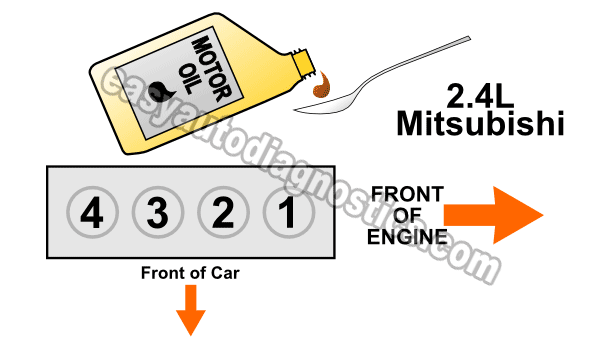Interpreting Your Compression Test Results
It's not unusual to see a low compression value among your compression test results.
Most of the time, a low compression value will not cause a problem. But if the value is too low, then you'll have a rough idle problem or a misfire problem on your hands.
What you have to do is find out if this low compression value varies by more than 15% of the highest compression value you obtained from your tests.
Why? Because if the low compression value varies by more than 15%, then this cylinder is going to misfire and can be considered 'dead'.
You can do this one of two ways: You can calculate this 15% difference with pen and paper or you can use my low compression calculator. You can find the low compression calculator here: Online Low Engine Compression Calculator.
If you want to manually calculate the 15% difference, here's what you'll need to do:
- STEP 1: Multiply the highest compression value by 0.15 (this is the decimal value of 15%).
- STEP 2: Round the result to the nearest one (for example: 25.6 would become 26).
- STEP 3: Subtract the result (the number that was rounded) from the highest compression value.
- ANSWER: The result of this subtraction is the lowest possible compression value any cylinder can have.
Now, let me give you a more specific example: Let's say that I got the following compression readings:
| Cylinder | Pressure |
|---|---|
| #1 | 165 PSI |
| #2 | 95 PSI |
| #3 | 155 PSI |
| #4 | 175 PSI |
My next step is to do the following calculation:
- STEP 1: 175 x 0.15 = 26.25.
- STEP 2: 26.25 = 26 (rounded to nearest one).
- STEP 3: 175 - 26 = 149.
- ANSWER: 149 PSI. Any cylinder with this compression (or lower) value will misfire.
Since cylinder #2 is only producing 95 PSI, I can now conclude that it's 'dead' and causing a misfire.
To find out if the lowest compression value you got from your engine compression test is within a good range, you'll need to do the same calculation. Of course, you'll need to use the highest compression value you got and not the one in the example.
Once you've found the 'dead' cylinder, the next step is to find out what's causing the low compression value. For this step, go to: TEST 2: Wet Engine Compression Test.
TEST 2: Wet Compression Test

The very last step, if you have one or more cylinders that have very low compression values, is to do a wet compression test on those specific cylinders.
This type of test will help you find out if the low compression value is due to worn valves in the cylinder head or worn rings on the pistons.
This involves adding a spoonful of engine oil to the affected cylinder and testing the compression again.
OK, this is what you'll need to do:
- 1
Add a tablespoon of engine oil in the cylinder you need to retest.
I suggest using a small and long funnel so that the oil will reach the inside of the cylinder. - 2
Once you've added the oil, install the compression gauge and as before just hand tighten it.
- 3
Now, have your helper crank the engine till the needle stops climbing on the compression gauge.
- 4
You'll see one of two results:
1.) The needle will climb higher than the previous compression number you recorded for this specific cylinder.
2.) The needle will not move at all or stay at the same number you recorded earlier.
What ever value your compression tester reads, write it down again. - 5
Repeat steps 1 thru' 4 on any other cylinder with a low compression value.
Let's examine your test results:
CASE 1: The needle on the gauge registered a higher value. This tells you that the lack of compression (or low compression) recorded earlier is due to bad or severely worn piston rings.
CASE 2: The needle DID NOT move beyond the previous recorded value. This result tells you that the problem is due to worn intake or exhaust valves in the cylinder head.
Why An Engine Compression Test?
One of the things that can cause a misfire condition (also known as a miss or dead cylinder), is an engine cylinder or engine cylinders that produce less than normal compression.
When this happens, not matter what gets replaced (like spark plugs, spark plug wires, fuel injectors), nothing solves the miss. This is when the compression test comes in to save the day.
Over the years, I have solved many unsolvable misfire codes, rough idle, lack of power issues by doing a simple engine compression test and if you're faced with something similar then I highly recommend doing an engine compression test.
More Diagnostic Tutorials
To see all of the 1.8L and 2.4L Mitsubishi (Dodge, Chrysler) specific articles here at troubleshootmyvehicle.com, go to: Mitsubishi 2.4L Index Of Articles.
Here's a sample of the articles, you'll find in the Index of Articles:
- Crank Sensor Test And Ignition Coil Tests.
- MAF Sensor Test.
- Throttle Position Sensor Test.
- How To Test The Alternator.
- How To Bench Test The Starter Motor.

If this info saved the day, buy me a beer!

